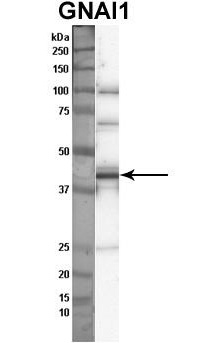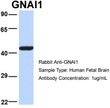G protein alpha inhibitor 1 (GNAI1) Rabbit Polyclonal Antibody
Other products for "GNAI1"
Specifications
| Product Data | |
| Applications | WB |
| Recommended Dilution | WB |
| Reactivities | Human, Mouse, Rat |
| Host | Rabbit |
| Isotype | IgG |
| Clonality | Polyclonal |
| Immunogen | The immunogen for anti-GNAI1 antibody: synthetic peptide directed towards the middle region of human GNAI1. Synthetic peptide located within the following region: YQLNDSAAYYLNDLDRIAQPNYIPTQQDVLRTRVKTTGIVETHFTFKDLH |
| Formulation | Liquid. Purified antibody supplied in 1x PBS buffer with 0.09% (w/v) sodium azide and 2% sucrose. Note that this product is shipped as lyophilized powder to China customers. |
| Purification | Affinity Purified |
| Conjugation | Unconjugated |
| Storage | Store at -20°C as received. |
| Stability | Stable for 12 months from date of receipt. |
| Predicted Protein Size | 40 kDa |
| Gene Name | G protein subunit alpha i1 |
| Database Link | |
| Background | Guanine nucleotide-binding proteins (G proteins) form a large family of signal-transducing molecules. They are found as heterotrimers made up of alpha, beta, and gamma subunits. Members of the G protein family have been characterized most extensively on the basis of the alpha subunit, which binds guanine nucleotide, is capable of hydrolyzing GTP, and interacts with specific receptor and effector molecules. The G protein family includes Gs and Gi, the stimulatory and inhibitory GTP-binding regulators of adenylate cyclase; Go, a protein abundant in brain (GNAO1); and transducin-1 (GNAT1) and transducin-2 (GNAT2), proteins involved in phototransduction in retinal rods and cones, respectively.Guanine nucleotide-binding proteins (G proteins) form a large family of signal-transducing molecules. They are found as heterotrimers made up of alpha, beta, and gamma subunits. Members of the G protein family have been characterized most extensively on the basis of the alpha subunit, which binds guanine nucleotide, is capable of hydrolyzing GTP, and interacts with specific receptor and effector molecules. The G protein family includes Gs (MIM 139320) and Gi, the stimulatory and inhibitory GTP-binding regulators of adenylate cyclase; Go, a protein abundant in brain (GNAO1; MIM 139311); and transducin-1 (GNAT1; MIM 139330) and transducin-2 (GNAT2; MIM 139340), proteins involved in phototransduction in retinal rods and cones, respectively (Sullivan et al., 1986 [PubMed 3092218]; Bray et al., 1987 [PubMed 3110783]). Suki et al. (1987) [PubMed 2440724] concluded that the human genome contains at least 3 nonallelic genes for alpha-i-type subunits of G protein; see, e.g, GNAI2 (MIM 139360), GNAI3 (MIM 139370), and GNAIH (MIM 139180). [supplied by OMIM]. Sequence Note: The RefSeq transcript and protein were derived from genomic sequence to make the sequence consistent with the reference genome assembly. The genomic coordinates used for the transcript record were based on alignments. Publication Note: This RefSeq record includes a subset of the publications that are available for this gene. Please see the Entrez Gene record to access additional publications. |
| Synonyms | Gi |
| Note | Immunogen Sequence Homology: Dog: 100%; Pig: 100%; Rat: 100%; Human: 100%; Mouse: 100%; Yeast: 100%; Bovine: 100%; Rabbit: 100%; Horse: 93%; Guinea pig: 93%; Zebrafish: 85%; Goat: 79%; Sheep: 79% |
| Reference Data | |
| Protein Families | Druggable Genome |
| Protein Pathways | Axon guidance, Chemokine signaling pathway, Gap junction, Leukocyte transendothelial migration, Long-term depression, Melanogenesis, Progesterone-mediated oocyte maturation, Tight junction |
Documents
| Product Manuals |
| FAQs |
{0} Product Review(s)
0 Product Review(s)
Submit review
Be the first one to submit a review
Product Citations
*Delivery time may vary from web posted schedule. Occasional delays may occur due to unforeseen
complexities in the preparation of your product. International customers may expect an additional 1-2 weeks
in shipping.






























































































































































































































































 Germany
Germany
 Japan
Japan
 United Kingdom
United Kingdom
 China
China





